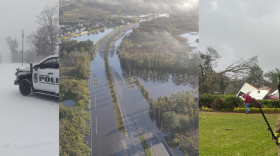While red tide rages along Southwest Florida’s Gulf coast, blue-green algae is making its way westward along the Caloosahatchee River toward the Gulf. The Florida Department of Health in Lee County recently issued a health advisory for the Alva Boat Ramp, Davis Boat Ramp, and the Franklin Lock and Dam.
In what has become an annual event, the coasts of Florida are bracing for the inevitable influx of cyanobacteria, which is also known as Blue-green algae. In 2016 when the state’s east coast was coated in guacamole-like algae from the St. Lucie River, it made national headlines. John Cassani with the non-profit Calusa Waterkeeper said he’s never seen toxicity levels like what he’s finding this summer.
“We’re seeing microcystine toxin levels approaching 2,000 mcg/l (micrograms per liter). High probability for adverse health effects from this toxin is in the 50-100 mcg/l range and we’re like 50-500 times higher than that,” that Cassani. “So this is horribly toxic stuff.”
NOAA (National Oceanic and Atmospheric Administration) imagery shows almost all of Lake Okeechobee is covered in blue-green algae.
Chris Whitman is a fishing boat captain and a member of Captains for Clean Water. He says water management with Lake Okeechobee is political.
“It’s frustrating,” said Whitman. “I didn’t become a fishing guide to be wearing a suit and taking trips to Tallahassee and Washington D.C., and sitting in an office trying to fix water issues. I became a fishing guide to share what I love about the state of Florida.”
Late last week the U.S. Army Corps of Engineers announced Lake O releases would stop for nine days, but only to the east. Discharges into the Caloosahatchee River will continue sending the algae-laden water to Southwest Florida coasts.
https://www.youtube.com/watch?time_continue=2&v=1HvKxy3sfCY
Meanwhile, beachgoers and marine life continue to suffer impacts from a persistent red tide algae bloom that has been plaguing Southwest Florida’s Gulf Coast since this past fall.
Staff at the Center for the Rehabilitation of Wildlife, or CROW, on Sanibel Island report that the flow of animals coming into their wildlife hospital with toxic red tide poisoning has remained steady since October 2017. Cyanotoxins from blue-green algae are a concern, but that has not yet hit Sanibel Island. CROW hospital director Heather Barron, said this red tide bloom is hitting endangered sea turtles particularly hard.
“We’re having a number of adult loggerheads washing up on the beach. Some of them have already died. Some of them are very ill,” said Barron.
“It’s a particularly depressing time for this to be happening because these are the adult animals who are coming in to lay their eggs and to mate. So it is particularly disheartening to see this population being so effected because it’s really going to have an impact on the number of hatchlings that we have this year.”
Barron said they’ve also been treating Green and Kemps Ridley sea turtles with red tide poisoning as well as a variety of sea birds. Barron said the birds she treats for red tide toxicosis are typically juvenile or first-year birds. CROW’s ongoing clinical research is aimed at improving diagnosis and treatment of red tide toxicosis.









